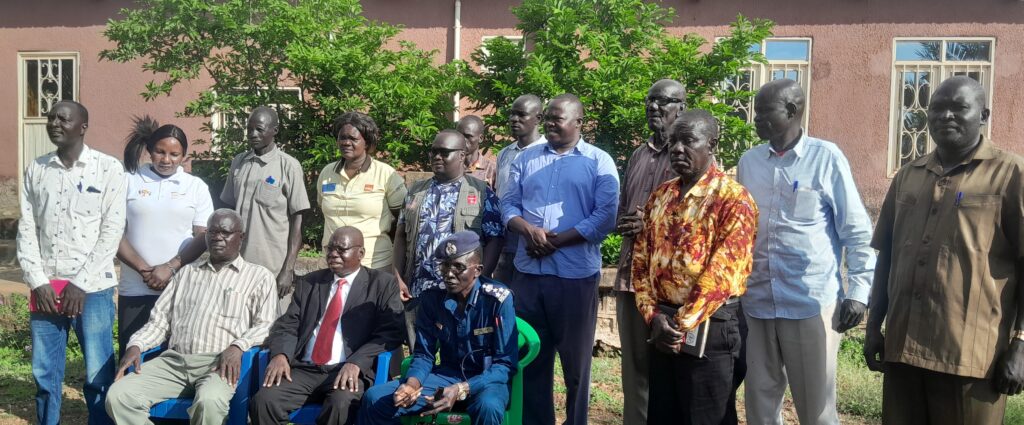The South Sudan National Ministry of Health announced plans to start a major medical campaign next week targeting Onchocerciasis (OV) and Elephantiasis in Western Bahr el Ghazal State, specifically in Jur River County. This campaign will focus on individuals aged 5 years and above.
This initiative follows the detection by health partners that 19 of the 20 neglected tropical diseases are endemic in South Sudan, posing significant health threats, particularly in Western Bahr el Ghazal, Western Equatoria, and Warrap states.
OV and Elephantiasis are serious health risks that can cause severe pain, disabilities, and deformities among South Sudanese people.
Speaking to Radio Tamazuj on Monday, Gabriel Mabith Malek, the National Ministry of Health representative in Jur River to support the campaign, said they started with training Payam and Boma supervisors on Tuesday. These supervisors will oversee the campaign in the county.
“We began today with training for Payam supervisors, which will last for two days. We will also train Boma supervisors at the Payam level. After this training, they will conduct a CDC training. These are the individuals who will administer the drugs in Jur River County,” said Malek.
“The campaign will have two coverage areas: geographical coverage of 100 percent in Jur River County and therapeutic coverage of 85 percent and above. The campaign will be house-to-house and will last for five days,” Malek explained.
He emphasized that lactating mothers and children under five years are not eligible to receive the drugs. “Children under five, pregnant mothers, and lactating mothers who have delivered within the past seven days, as well as very sick people, will not take the drugs,” Malek added.
Since 2021, millions of people in South Sudan have received treatment for river blindness, elephantiasis, bilharzia, trachoma, and soil-transmitted worms. In June 2023, health workers conducted a house-to-house mass drug administration against bilharzia, ensuring eligible children received treatment regardless of infection status.
Neglected tropical diseases, a group of 20 diseases, primarily affect tropical and subtropical regions. They include lymphatic filariasis (elephantiasis), onchocerciasis (river blindness), schistosomiasis (bilharzia), human African trypanosomiasis (sleeping sickness), chronic ulcers, and other skin infections.
Western Bahr el Ghazal State OV coordinator, Philip Dor Uchalla, explained that the insects transmitting these diseases dwell in forests and dark places. “These flies move short distances looking for food, taking human blood and transferring millions of parasites to a person,” Uchalla said. The parasites develop into microfilariae, residing in human skin and causing chronic skin diseases.
Jur River County Health Director, Kuol Kuot, urged residents to participate in the campaign. “My message is to the 15 payams of Jur River, especially the six major payams: Kwajiena, Roc-Roc Dong, Marial-Bai, Wan-Bai, Udici, and Kangi. From 28 July to 3 August, we will distribute drugs for OV and LF diseases,” said Kuot.
The Ministry of Health recently received a consignment of Ivermectin and Albendazole from the United States for OV and Elephantiasis prevention. In January, the WHO supported the Ministry to develop and implement a Neglected Tropical Disease Master Plan 2023–2027. This plan includes training health workers nationwide in disease management, treatment, diagnosis, mapping, mass drug administration, case search, and contact tracing.
The Master Plan aligns with the 2030 Neglected Tropical Diseases Global Roadmap, which aims to eliminate diseases like bilharzia, river blindness, elephantiasis, intestinal worms, and trachoma by 2030.
South Sudan’s master plan aims to shift its approach to tackling neglected tropical diseases by focusing on three key areas: increasing accountability for impact using specific indicators, integrating disease-specific programs, and changing operating models to promote greater national ownership.
Several counties in South Sudan are affected by multiple neglected tropical diseases. Elephantiasis and river blindness are endemic in 34 counties, while bilharzia and intestinal worms are endemic in 46 counties. Additionally, 35 counties have both elephantiasis and intestinal worms, and 36 counties have co-endemicity of Loa-Loa Filariasis. Recent mapping indicates that leprosy is endemic across all regions of the country.




